Water conservation is becoming a bigger priority for many U.S. households, especially in areas affected by drought or high utility costs. A simple, effective way to save water at home is by installing a rain barrel. They collect rainwater from rooftops and store it for later use in gardens, lawns, or outdoor cleaning. Easy to set up and environmentally friendly, rain barrels allow homeowners to reduce reliance on municipal water while contributing to sustainable living practices.
Why Use a Rain Barrel?
Rain barrels serve two main purposes: saving water and reducing runoff. Every time it rains, large amounts of water flow from rooftops into storm drains, often carrying pollutants into local waterways. By capturing this water, you not only reduce waste but also help protect the environment.
For gardeners, the benefits are immediate. Plants often respond better to natural rainwater than to treated tap water, which may contain chlorine or other additives. Over time, even modest savings add up, making rain barrels a practical solution for both your wallet and the planet.
Choosing the Right Location
The effectiveness of a rain barrel depends on where you place it. The best spot is typically under a downspout connected to your home’s gutters. This ensures that rainwater from the roof is directed straight into the barrel.
When selecting a location, consider a few factors. The ground should be level and stable to support the weight of a full barrel. Position it near the area where you’ll use the water, such as a garden or lawn, to make distribution easier. If possible, elevate the barrel on a sturdy platform to increase water pressure when using a hose or spigot.
Installation Basics
Installing a rain barrel is a straightforward project for most homeowners. Begin by cleaning your gutters to make sure water flows smoothly into the downspout. Next, cut the downspout so it aligns with the top of your barrel. Many rain barrel kits come with diverters or flexible tubing that make this process easier.
Most barrels include an overflow valve to redirect extra water during heavy rain. Be sure to connect a hose or extension pipe to this valve and direct the overflow away from your home’s foundation. Adding a fine mesh screen at the top of the barrel helps keep out leaves, debris, and insects such as mosquitoes.
Using Collected Water Safely
Rainwater collected in barrels is best used for outdoor purposes. Common uses include watering gardens, filling birdbaths, rinsing tools, or washing outdoor furniture. While rainwater is generally clean, it may pick up contaminants from your roof, so it is not recommended for drinking unless it has been properly filtered and treated.
It’s also important to maintain your system. Empty and clean the barrel once or twice a year to prevent algae buildup. During colder months in regions where temperatures drop below freezing, disconnect and store the barrel to avoid cracking. Regular maintenance keeps the system effective and extends its lifespan.
Adding Efficiency with Multiple Barrels
For households with larger roofs or higher water needs, linking multiple rain barrels can increase capacity. This is done by connecting barrels with hoses or spigots so that when one fills, the overflow moves to the next. This setup is especially useful for avid gardeners or families with large outdoor spaces.
By expanding capacity, you can make the most of heavy rainfall events and reduce the number of times you need to rely on tap water. Even in regions with moderate rainfall, a connected system ensures you capture as much as possible.
Small Steps Toward Big Savings
Installing a rain barrel is a simple yet powerful way to practice water conservation at home. By capturing rainfall, you reduce runoff, lower your utility use, and provide your garden with a natural water source. The installation process is beginner-friendly, and with proper care, a rain barrel can serve your household for years.
Small efforts like these not only support your own budget and garden but also contribute to broader environmental sustainability. In the end, every drop saved makes a difference.

